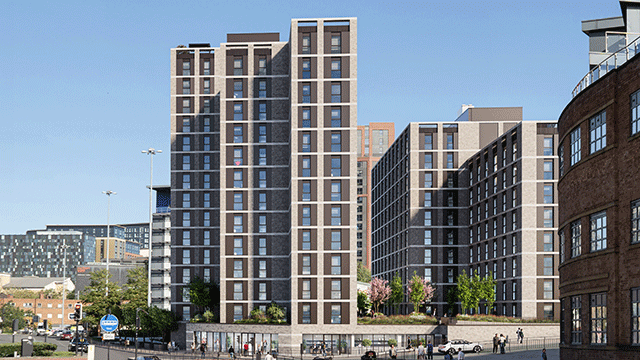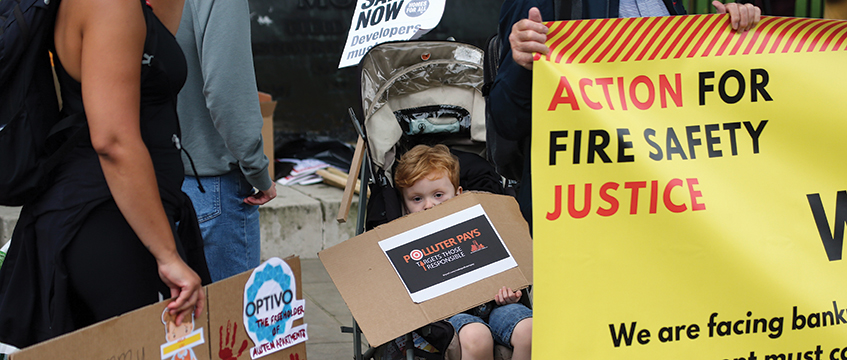Landlord and tenant – Service charges – Construction of lease – Respondent holding lease of flat containing no variable service charge provisions – Respondent granted right of way over communal stairway and landing conditional on paying half maintenance costs – First-tier tribunal deciding respondent not required to contribute to cost of roof repairs over part of stairwell – Appellant landlord appealing – Whether right of way extending to structures enclosing stairwell and roof covering – Appeal dismissed
The respondent held the lease of a one-bedroom flat on the first floor of a block of flats on a former local authority housing estate at Coleford, Gloucestershire (the property). The appellant was the landlord.
Following a routine inspection of the building in 2018, water was found to be penetrating through part of the roof above the communal stairwell. The appellant’s surveyor determined that the roof tiles would have to be removed, the roof felt and batons replaced and the roof re-tiled using the original tiles. The work was complicated by the presence of asbestos surrounding some of the timber beams.
The appellant applied under section 27A of the Landlord and Tenant Act 1985 for a determination whether expenditure incurred in carrying out the roof repairs could be recovered from the respondent. The application also included a request under section 20ZA of the 1985 Act, for dispensation from the relevant statutory consultation requirements.
The First-tier Tribunal (Property Chamber) (FTT) decided that the respondent was not liable to contribute towards costs incurred by the appellant in carrying out repairs to the roof covering the communal stairwell and first floor landing providing access to the flat. The FTT decided that the lease did not include any provision under which the respondent could be required to contribute towards those costs. If it had done, the FTT was satisfied that no prejudice had been caused by the appellant’s omission to consult before carrying out works, and the cost of the works had been reasonable. The appellant appealed.
Held: The appeal was dismissed.
(1) The appellant had criticised the FTT’s use of the contra proferentem principle that, where ambiguity existed in the meaning of a contractual clause, the words used should be construed against the interests of the party assumed to have been responsible for drawing up the document. The tribunal agreed that premature resort to the contra proferentem principle was not appropriate and, if it was to be used at all, it should be the last tool to be employed, not the first: Fishbourne Developments Ltd v Stephens [2020] EWCA Civ 1704; [2021] EGLR 9 considered.
The court’s task when construing the contract was to ascertain the objective meaning of the words used by the parties in the context of the contract as a whole, taking into account the relevant factual background which would have been available to the parties, but excluding subjective evidence of the parties’ intentions. The court had to focus on the meaning of the relevant words in their documentary, factual and commercial context. If there was an ambiguity, the court could give weight to the implications of the rival constructions by reaching a view as to which was more consistent with business common sense: Rainy Sky SA and others v Kookmin Bank [2011] UKSC 50, Arnold v Britton and others [2015] EGLR 53 and Wood v Capita Insurance Services Ltd [2017] AC 1173 considered.
(2) The FTT was right that the lease did not oblige the leaseholder to contribute towards the costs of repairs to the roof over the stairwell. As a matter of language, the extent of “the whole or any part or parts of such stairway and landing” referred to in paragraph 11 of the lease (which granted a right of way over the stairway and landing leading from the entrance area to the flat on the upper floor) was limited to the structures over which the leaseholder had been granted a right to pass, and did not include the structures enclosing the stairwell or the roof covering it over which the leaseholder had been granted no rights. The careful scheme of proportionate contributions based on usage also supported the straightforward construction requiring the leaseholders to contribute only towards the cost of maintaining the routes over which they had access, and not any other part of the structure of the building, including the walls enclosing those routes or the roof covering them.
The leaseholder was granted an unqualified right of support and protection from the roof of the building which was not conditional on making any contribution towards the cost of repair of the roof. It was a clear indication that the parties did not contemplate that the lessee would be required to contribute towards the cost of repairs to the roof.
The lease plans were sufficiently detailed to enable the parties to identify precisely which parts of the structure the lessee was to have rights over and was to contribute towards. There was no separate roof over the stairwell and no indication that the cost of works to the roof was to be apportioned into costs referable to the part of the roof covering the stairwell and cost referable to other parts of the roof and no mechanism for that to be done or for any disagreement over an apportionment to be resolved.
(3) The proportions in which the leaseholder was required to contribute to the maintenance of different areas were based on usage, not benefit, and they broke down if applied to the structural components of the building which enclosed, but did not form part of, the routes of the different rights of ways. The storerooms on the ground and upper floors comprised around a quarter of the floor area of the projecting structure at the front of the building which housed the stairwell and landings. A quarter of the external walls of that structure enclosed the storerooms and a quarter of the roof over it covered the storerooms on the upper floor. The storerooms were clearly not part of the internal paved entrance area, or of the stairway or landing, and there was no basis on which the leaseholder could be required to contribute to their repair, or to the repair of the structural parts of the building which enclosed them.
Those were powerful indicators that the parties did not intend the respondent leaseholder to be liable as a condition of access to his flat to contribute to the repairs of the roof over the stairwell. The right of way did not extend to the structures enclosing the stairwell or the roof covering it.
James Fieldsend (instructed by Birketts LLP) appeared for the appellant; the respondent in person.
Eileen O’Grady, barrister
Click here to read a transcript of Two Rivers Housing v Sanders








